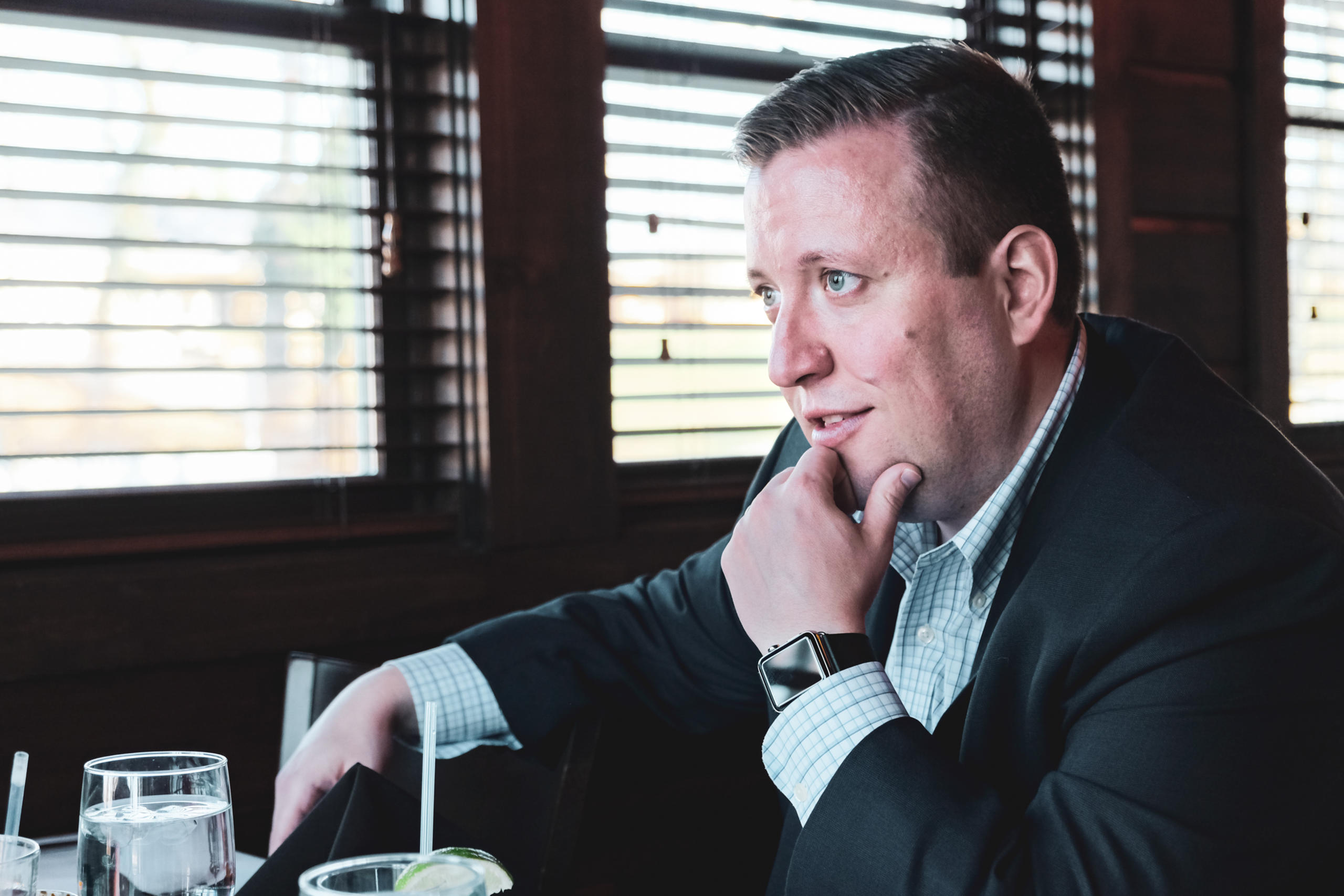
5 Ways to Make Social Impact through Tech from Jason Kloth
Want your product to solve big problems? If so, Jason Kloth says you’d better get comfortable with navigating uncharted territory. Innovation means finding new ways forward, not following old roadmaps. “To tackle the big problems facing society, you’re inherently going to be stepping out into the unknown,” Jason explains. “It’s all about clearing a path through the ether.”
He’s done just that throughout his career in various leadership roles at Teach for America and then as deputy mayor of Indianapolis. Now as president and CEO of Ascend Indiana, he’s using technology to solve complex issues in Indiana’s labor market. Ascend’s platform acts like a Match.com for hiring—helping employers find qualified talent and vice-versa.
To tackle the big problems facing society, you’re inherently going to be stepping out into the unknown
By stepping out into the unknown, Jason is creating transformative technology to address large-scale problems. He shares five questions innovators should ask themselves as they navigate the way forward:
1. What’s Really Causing the Issue You Want Your Product to Solve?
More often than not, the issue you set out to address will be a many-headed monster. You can’t just tackle the problems that bubble up to the surface. You’ve got to figure out what’s causing those problems before you can build a product that contributes to systemic change. In the case of Ascend, this started with taking a deeper look at Indiana’s economy.

The idea for Ascend began in 2016. Jason was working as deputy mayor at the time. “We were running a structural deficit that was the equivalent of 50,000 people earning $50,000 a year,” he explains. So Jason looked into the issue, meeting with Indiana employers and asking what they needed to expand their businesses and hire more people.
He was surprised by what he heard. “They weren’t saying, ‘We need a huge tax abatement,’ or ‘The issue is high taxes,’” Jason recalls. “What they were really looking for is the talent they needed to grow that business, and we did not, as a community, have a turnkey solution to address that problem.”
Simultaneously, the Central Indiana Corporate Partnership (CICP), an organization that brings together industry, higher education and philanthropic leaders to advance our region, was recognizing talent as a major challenge to economic growth and opportunity. Jason, alongside Ascend’s co-founder, Stephanie Bothun, developed a white paper to research the magnitude of the problem. With the support of CICP, they raised nearly $1M in initial funding, signaling that Jason and his team were focusing on the right problems from the beginning—even before they started building their platform.
The Takeaway: You can’t design a solution to a problem if you don’t truly understand the problem. Take an in-depth, comprehensive look at the issue before concepting product.
2. What’s Your Vision for Your Product?
After Jason’s team identified the gap in Indiana’s labor market, he needed to figure out what he and CICP could do to help. Once again, they turned to the research to examine what was really going on.
They found that demand for highly skilled workers was going up, but that the supply of these workers wasn’t keeping pace. Meanwhile, fewer and fewer traditional factory jobs were becoming available, with more people looking to fill those jobs every year. In other words, the workers coming out of the educational pipeline weren’t matching the job market’s needs.
This helped Ascend understand what kind of product they needed to build. “What we want to try to do is do a better job of matching talent with those opportunities,” Jason explains. “Build an increasing supply of people with the education they need to take those jobs … and then inform public policy so that we can build a larger supply in the future. That’s how we preserve a balanced middle-class society, a growing economy.”
From this, Jason and Ascend created a succinct vision: “For every employer to have access to the talent they need. For every person to be able to pursue a meaningful self-sustaining career.” Specific emphases might change over time, but as Jason says, “The basic vision always remains the same.”
Ascend’s talent matching platform was born directly out of this vision. And the vision continues to provide a framework for important decisions. It’s no longer a question of, “Does this sound like a good idea for our product?” but rather “Does this support our vision of giving employers access to talent and helping individuals pursue meaningful careers?”
The Takeaway: Your vision acts as a guiding light when the path ahead is uncertain. It should be clear and strategic—grounded in research, not guesswork.
3. How Will You Measure Product Success?
Jason recommends starting with a clear vision. Your vision represents the end state when you are successful. “Then set clear priorities, which are qualitative measures to the vision, and clear goals, which are quantitative measures.”
For example, Jason explains, imagine your organization’s vision is a world where everyone has access to life-saving vaccines. It’s not simply a matter of turning on a conveyor belt and manufacturing more doses. To accomplish your overall goal, you’ve got to meet several different objectives. “Naturally, you have to do research to create vaccines in the first place,” he says. “You also have to distribute vaccines. You have to market vaccines. Those are priorities.”
Once you’ve established these qualitative priorities, you need a way to measure your progress. That’s where quantitative goals come in. In the case of vaccines, Jason says, this might be something like, “We want to create three vaccines that address these specific diseases by this timeframe, and then, we’re going to distribute X number of vials.”
For Ascend, Jason and his team identified three main priorities:
- Placing talent into Indiana jobs and internships,
- Building sustainable talent pipelines directly for businesses, and
- Conducting research and informing public policy.
Ascend measures its progress using quarterly and annual goals. For a different model, you might set biannual, weekly or even daily goals. It all depends on what works best for your context, but no matter what, it’s essential to have that structure. Jason says: “Those kinds of systems give you the ability to work through problems and see what’s going on as clearly as possible.”
The Takeaway: You’ll lose your way if you don’t have progress markers. Establish clear benchmarks and check in regularly to see if your product is accomplishing what you set out to do.
4. Do You Have The Right People On Your Team?
As a leader, you help clear the path to progress, but you can’t do it all on your own. Ongoing innovation requires a skilled, dedicated team. Jason says he learned this lesson early in his career: “Teach for America really drove home the notion that … everything will be driven by the people that make up that team.”
Ascend’s Leadership Team exemplifies a culture of achievement. For example, Stephanie, Ascend’s Vice President of Strategy, graduated with honors from the Kelley School of Business, was named Teacher of the Year by the Indianapolis office of Teach for America, and spent several years consulting with Deloitte. Kate Broshears, the Vice President of External Affairs, earned two master’s degrees and recently qualified for – and completed – the Boston Marathon. Sally Reasoner, the Vice President of Talent Identification, launched her career through the Orr Fellowship and went on to found a number of TechPoint’s premier talent programs.
Of course, evaluating candidates isn’t just a question of skill. It’s also about finding a good fit in terms of personality. “We hire for very specific sets of character traits that are most likely to yield really, really good results,” Jason goes on. “Perseverance, organizational ability, the ability to influence and motivate others, and humility.”
Your team must be supportive of your vision, priorities and goals. So Jason says you’ve got to be deliberate about shaping the company ethos. “If you do not define culture, culture will be defined for you,” he says. “We have a very clear vision, very clear priorities, very clear goals, and a team of people who own those goals. … We are the best professional selves when we’re operating with these values at the core of how we operate day-to-day.”
You’ve got to be deliberate about shaping the company ethos.
He adds that it’s essential that your organizational culture remains open to new ideas. “When you’re developing a piece of technology, having a sense of possibility is a really important value to have,” he says. “If we are going to seek transformative solutions to large scale problems, we’ve got to be comfortable with ambiguity on the path to clarity.”
The Takeaway: Products alone don’t solve problems. The people behind the products do. Your solution can only be as successful as the team carrying it out, so hire wisely.
5. How Are You Scaling Your Solution?
According to Jason, far too many organizations fail to think ahead of time about scaling their solutions. For non-profits especially, this is one of the biggest limiting factors on growth. “Not all non-profits know about the efficiencies that can be gained in that way,” he says. “They don’t always utilize technology to solve problems at scale.”’
Far too many organizations fail to think ahead of time about scaling their solutions.
Jason cites Georgia State University as a prime example of doing things the right way. They wanted to improve graduation rates by identifying roadblocks for students, but they simply didn’t have the manpower to meet each individual student and find out what he or she needed. So instead, the university analyzed larger data sets to make systemic changes instead of working only on a case-by-case basis.
For example, GSU found that reducing the wait time for admission to the pre-nursing program could reduce students’ overall debt and improve retention. They also automated their scholarship system to predict which students were on the verge of dropping out and awarded financial aid to help those students stay in school.
“This non-profit, higher education institution was able to very thoughtfully, piece by piece, improve outcomes for students, and now, those outcomes are being learned across the higher education system,” he says. “My hope is that a lot of non-profits move this way in the future because there’s a tremendous amount of benefit that could be gained.”
Ascend did just this, working to make its tech scalable from the very beginning. “When we started, we viewed ourselves as truly tech-enabled,” Jason says. “We were building a tool that would enable our recruiters to match talent more effectively. … These solutions will scale over time, so we’re going to be able to help thousands of people find jobs on an annual basis.”
The Takeaway: To address large-scale problems, you need large-scale solutions. Multiply your efforts by building tech with scalability in mind.
Remember What You’re Working Toward
When you start out, the road ahead is unclear. And then with time, Jason says, “A path starts to unfold in front of you.” It’s exciting to see progress, but it can also be discouraging to realize how much there is to be done. As Jason puts it: “That path is usually largely uphill and has lots of obstacles and barriers along the way.”
“We are going to help a tremendous number of people and institutions, and that is the reward. That is the why behind what we’re doing.”
Keeping an eye on the end goal can help motivate you and your team. For Jason, this means thinking about all the people Ascend’s platform will be able to help. “We are going to make school more affordable for many, many people; we’re going to help grow companies and grow the economy,” Jason says. “We are going to help a tremendous number of people and institutions, and that is the reward. That is the why behind what we’re doing.”



